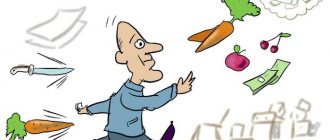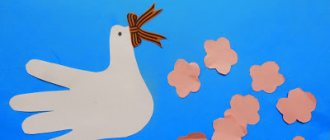Daily planning in the middle group for the month of March
Morning. Reception of children and examination.Game activity on the topic: “Why know the rules of the road?” - help to learn the basic rules of the road, give an idea of the operation of a traffic light and its signals
Did. game “Pets and their young”: develop thinking, speech and memory. Encourage listening to other children's answers.
Labor: instruct Ksyusha M. to help the assistant teacher lay out spoons for breakfast and arrange glasses - cultivate a desire to help adults
Self activities at the request of the children.
Finger gymnastics “We chop cabbage...” - development of children’s speech
Preliminary work of GCD on modeling. Looking at the thematic dictionary “Poultry”, looking at a toy duck, conversation “Who lives in the poultry yard?”, reading the poem “Duck” by V. Miryasova.
Morning exercises.
Didactic game “What time of year?” - teach children to correlate descriptions of nature in poetry or prose with a certain time of year
Individual work. Train knowledge about the seasons with Sumaya, Yasmina, Anya, Kolya, Damir, Ksyusha.
Observation “Windy weather” - invite children to determine the strength of the wind using one of the methods known to them, characterize the wind (strong, moderate, gusty, cold), compose a story based on the results of observation about what happens in windy weather (the wind quickly drives clouds across the sky , people raise their collars).
The outdoor game “Geese-geese” is to teach children to act on a signal, develop attention, and develop the ability to act in accordance with the rules of the game.
Independent motor activity of children. Teach children to independently organize games, find activities of interest, and use a variety of sports attributes in physical activity.
Evening. Gradual rise. Clean up the bedroom after sleep yourself, learn to fold blankets.
Role-playing game "Kindergarten". The plot "I am a teacher." Observe the general orientation and specific actions of children who have taken on the role of educators, invite the children to play out various problematic situations.
The plot-role-playing game “Chauffeurs” is to develop the social relationships of the players by understanding the professional activities of adults, to promote the formation of friendly relationships between children.
Work. Maintaining order and cleanliness in the group and in the booths. Cultivate accuracy and respect for the work of others.
Independent play and creative activities for children as desired.
Long-term plan for conversations in the middle group (March, April, May)
Olesya Raevskaya
Long-term plan for conversations in the middle group (March, April, May)
MARCH
1. Conversation on the topic: “It’s not without reason that winter is angry”
- introduce children to F. Tyutchev’s poem, talk about folk superstitions: “March is not faithful, sometimes it cries, sometimes it laughs,” “No matter how angry winter is, it will still submit to spring.”
2. Conversation on the topic: “You can’t offend girls”
- to form a caring, attentive, “knightly” attitude towards girls (do not offend, do not tease, give in, protect)
3. Conversation on the topic: “Beloved Mommy”
- make you want to tell about your mother, where she works, how to take care of her family (cleans, washes, cooks, plays with children, what she likes to do in her free time, cultivate love for your closest and dearest person.
4. Conversation on the topic: “My mother is the best”
— expand children’s understanding of the family, teach them to read poems about mothers, show care and attention to their mother, and make them want to decorate the group for the holiday
5 Conversation on the topic: “How we celebrated March 8th”
- evoke a desire to share impressions of the matinee, tell how they congratulated mother and grandmother at home, and develop children’s connected speech.
6 Conversation on the topic: “Spring is coming”
- note changes in nature, talk about the life of animals and birds, about people’s work in the spring (look at illustrations, remember poems about spring) - develop children’s observation, curiosity, and speech.
7 Conversation on the topic: “What to do? "
— teach children to make the right decision in various life situations, to control their behavior when communicating with other people.
8 Conversation on the topic: "Magic words"
— teach children the rules of etiquette, forms of communication when meeting with adults and children, the rules of using words of greetings and gratitude, and help overcome shyness and constraint in children.
9 Conversation on the topic: “My favorite animal”
— teach children to share their impressions, write descriptive stories about their pet (what it looks like, how to play with it, how to care for it, what its habits are).
10 Conversation on the topic: “We know how to talk politely”
- consolidate the ability to thank for a service, learn to use different speech forms when meeting and saying goodbye.
Sports week
11 Conversation on the topic: “Sport is the key to health”
- note what kinds of sports there are (football, basketball, gymnastics, boxing, figure skating.) - find out their diversity, note that people who play sports have good health.
12 Conversation on the topic: "Tourists"
- introduce such a sport as tourism, note what attributes it uses (tent, compass, backpack, bowler hat.), give knowledge about the meaning and benefits of this sport.
13 Conversation on the topic: "About football players"
- to give knowledge about the sport - football, to note what objects football players use, to create a desire to play sports.
14 Conversation on the topic: "About hockey players"
- give knowledge about a sport like hockey, that the objects of the game are a puck and a stick. Develop connected speech, attention, and create a desire to play sports.
APRIL
1 Conversation on the topic: "April 1st - Day of Humor"
- tell the children about the tradition - on this spring day, make fun of each other, have fun, tell funny stories.
2 Conversation on the topic: “How to play and not quarrel”
— to develop the ability to act fairly, resolve controversial situations using the order in performing roles, use a toy, etc.
3 Conversation on the topic: “Get ready to exercise!” "
— talk about the importance of morning exercises and daily routine for health; read the fairy tale by T. Shorygina “Exercise and a cold”
4 Conversation on the topic: “I will not be afraid”
- find out what children are afraid of, teach them to overcome their fear, teach them to listen to the statements of their comrades without interrupting.
5 Conversation on the topic: "Green friends"
- consolidate the names of familiar plants, continue to teach to distinguish the parts of the plant and the necessary conditions for growth (watering, light, heat).
6 Conversation on the topic: “What I love.” "
— learn to maintain a conversation, speak out on a proposed topic, listen carefully to others without interrupting, develop coherent speech
7 Conversation on the topic: “When adults talk”
- continue to develop the skills of politely addressing adults, teaching, not interrupting them, not interfering in the conversation of adults.
8 Conversation on the topic: “Relaxing with the whole family”
— develop the ability to compose a short story from personal experience, based on the teacher’s questions, learn how to construct sentences correctly.
MAY
1 Conversation on the topic: "May 1 is a holiday of peace and labor"
- propose to consider illustrations of the May Day holiday - develop knowledge about the phenomena of social life.
2 Conversation on the topic: “What kinds of stores are there?”
— consolidate knowledge about stores, their role in people’s lives, their diversity
(shoes, grocery, furniture, vegetables, cultivate a culture of behavior in stores.
3 Conversation on the topic: “The house in which I live”
- invite children to tell what kind of house they live in (private, multi-storey, consolidate knowledge of their address, rules of behavior at home.
4 Conversation on the topic: "May 9 - Victory Day"
- to give knowledge that during the war years our great-grandfathers and grandfathers bravely fought and defended our country from enemies, and how people preserve the memory of them. Foster respect for veterans of the Great Patriotic War.
5 Conversation on the topic: "Dangerous objects"
- give basic knowledge about safety rules at home, about handling matches, knives, hot objects, encourage them to draw the right conclusions in the proposed problem situations.
7 Conversation on the topic: "How to cross the street"
- consolidate knowledge about basic traffic rules, the meaning of traffic lights on the road, rules for regulating the movement of vehicles and pedestrians.
8 Conversation on the topic: “About healthy food”
- provide knowledge about healthy foods, their importance for health and good mood.
9 Conversation on the topic: “So that we don’t get sick”
- induce in children the need to take care of their health
(dress warmly in winter, don’t eat snow and ice, don’t scream in the cold, avoid slippery places on the road so as not to fall).
10 Conversation on the topic: “Our city”
- to give knowledge about the sights of our city, that in our city there are buildings with different purposes: kindergartens, schools,
hospitals, libraries, shops.
11 Conversation on the topic: “My home village”
- generalize ideas about the native village, its name, the street on which the garden is located, its attractions, teach them to recognize them in photographs.
Week: “It’s a Wonderful World”
1. Conversation on the topic: “How a frog lives”
- introduce the appearance and method of movement of the frog (big eyes, smooth skin, webbed feet, jumps, identify the meaning of frogs in nature. Read the story: » How it appeared
frog "
2. Conversation on the topic: “How a butterfly lives”
- introduce the appearance and method of movement of a butterfly
(large wings, different on the outside and inside, fold when she sits, making her less noticeable, small eyes, antennae, flies, reveal the meaning of butterflies in nature. Read the story: "How the butterfly appeared"
3. Conversation on the topic: “Flowers at the edge of the forest”
- introduce the variety of flowers of fields, meadows, gardens, consider the structure and features, identify the meaning of flowers in nature. Read the story: "How the flower appeared"
4. Conversation on the topic: “Birds are small”
- continue to introduce the appearance of birds, structural features (they have a beak, wings, feathers, claws, two legs, fly, flutter, identify the meaning of birds in nature. Read the story: "How did birds appear"
Conversation with children of the middle group on a spring theme
Conversation with children of the middle group “Who flies in the spring?”
Author: Skripnikova Valentina Mikhailovna. This conversation will be useful for educators of primary and secondary preschool age when preparing for a lesson on the world around us. Integration of educational areas: “Cognitive development”, “Speech development”. Goal: - to contribute to the expansion and enrichment of children’s ideas about birds in the spring, to develop curiosity, the desire to help and care for living beings. Objectives : - to contribute to the expansion and enrichment of children’s ideas about birds in the spring (bird arrival, nesting, hatching chicks, caring for them, human help);
Progress of the conversation.
Educator: - Spring has come - early spring. The warm, cheerful sun warms you up. The first thawed patches are already appearing on the hillocks and slopes of ravines. Streams run along the sides of the roads, dazzlingly sparkling in the sun. At this time, birds, heralds of spring, return to their native lands from distant warm countries. Spring! It's a wonderful day! Birds began to sing in the garden. Guess who the riddle is about: There is a palace on the pole. There is a singer in the yard. His name is... Children : - Starling. (Show corresponding picture).
Children describe the starling from the picture.
(A large, beautiful bird with shiny black plumage; the starling has a straight, long beak that helps get worms from the ground.)
Educator: - What is he like? Children: - He is all black, his beak is sharp, and his chest is speckled with white shiny spots. Educator: - Starlings are small birds, similar in appearance to thrushes, but unlike them, they walk on the ground and do not jump. The starling has a sharp black beak. During the breeding season, the beak color changes to yellow. The plumage is black, both in males and females, with a purple, green tint. In winter, white specks appear on the feathers. The starling's tail and wings are short. Finger gymnastics Spring has come, the icicles are melting, the first streams are singing, the bear is leaving its den, and the rooks are screaming in the fields. Alternately bending your fingers for each word. Claps for every word. Imitation of a bear's gait with all fingers on the knees. Rhythmic clapping for every word. Educator: - Guess the riddle. - There is a new house between the branches, there is no door in that house, only a round window, not even a cat can get through. Educator: - What kind of house is this? Children: - Birdhouse. Together with the teacher, the children look at the picture of the birdhouse and have a conversation. Educator : - Guys, look at the picture, what do you see in the birdhouse? Children: - eggs, starlings. Educator: - Guys, what do you think, is it possible to pick up eggs or small starlings? Children: - No. Educator: - Why not? Children: - You can break eggs carelessly, we can destroy the chicks. Educator: - Guys, what benefit or harm do birds bring? Children: - Save plants from harmful insects. — Birds decorate our nature. Educator: - Guys, which bird flies to us first? Children: - Rooks. - Look at his picture. - Describe him. —What do rooks eat in the spring? -Where do they build their nests? (Children's answers.) Educator: - The snow has not yet completely melted, but the rooks have already returned and are walking importantly through the fields. The rook is similar to the crow, but its beak is thinner and straighter. The plumage is black, with a purple tint. Rooks are omnivorous. They collect cereals, fruits and plant seeds from the fields; they may also eat earthworms and small rodents. They nest in colonies, building nests high in trees. Educator: - In the spring, birds have chicks. And now we will play the ball game “Who has who?” The rook has ....... rooks, rooks. At the nightingale... nightingale, nightingale. The stork has... little stork, little storks. The starling has...a little starling, little starlings. At the crane... baby crane, baby cranes. The siskin has... siskin, siskin. The swan has a baby, swans. The duck has... duckling, ducklings. The thrush has... thrush, blackbirds. Educator: - Well done guys, that's right. Guys, why are birds called friends of nature? Children: - Birds delight us with their singing, chirping, protect gardens, parks, squares from harmful insects. Educator: - Yes, if there are no birds, insects will eat all the vegetation, destroy crops in the fields and gardens, and an environmental disaster will occur. - Thank you, bird friends, for returning to your native land every spring! Analysis of the conversation : - Guys, who did we talk about in class today? - Children's answers. — Guys, I really liked how you worked in class. - Well done!
We recommend watching:
Summary of GCD on speech development in the middle group on the topic: Spring GCD in the middle group of kindergarten on the topic: Spring. Cognitive development Summary of educational activities on speech development “Spring has come” for children of the middle group Summary of educational activities for the middle group of kindergarten on the topic: Spring
Similar articles:
Summary of the lesson “Wild animals in spring” in the middle group
Summary of a spring walk in the middle group


